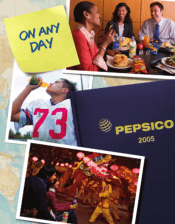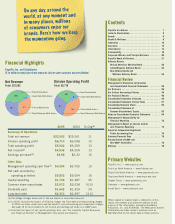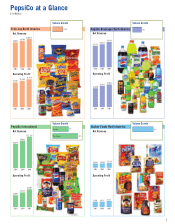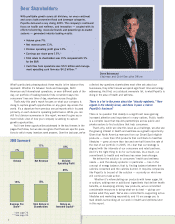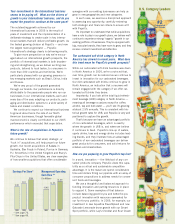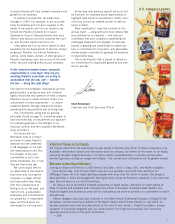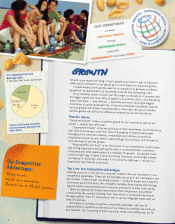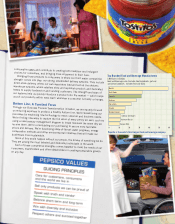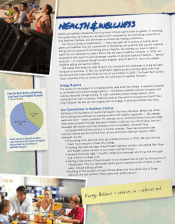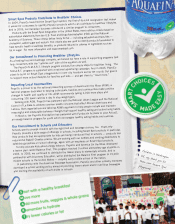Pepsi 2005 Annual Report Download - page 6
Download and view the complete annual report
Please find page 6 of the 2005 Pepsi annual report below. You can navigate through the pages in the report by either clicking on the pages listed below, or by using the keyword search tool below to find specific information within the annual report.
4
flavored potato chips contributed to solid growth
with our Lay’s brand.
But it also means balancing investment between
carbonated and non-carbonated beverages, and
balancing between “close-in” ideas like line exten-
sions, and entirely new product platforms that don’t
exist today. We’ve implemented new ways of
coordinating the collection of insights from
consumers and retail partners so we can better
share those insights across our businesses, and
generate ideas that have a greater chance of suc-
cess in the marketplace.
I think it’s important to understand that
innovation isn’t limited to products. Across
PepsiCo, we’re constantly innovating to strengthen
our go-to-market systems and to find structures
that drive faster, more efficient and more cost-
effective decision making. A current example is our
Business Process Transformation, or BPT, a
comprehensive, multi-year initiative that centers
on moving all of PepsiCo to a common set of
processes for key business activities, with current
efforts focused on North America.
More than a year ago, you announced PepsiCo’s
Business Process Transformation (BPT) initiative.
What are the objectives of this program, and
what is its status?
Through larger acquisitions and mergers over the
years, such as Tropicana and Quaker, we’ve recog-
nized the need to seamlessly integrate formerly
independent information systems. We’re also
committed to harmonizing key business processes
such as Finance, Consumer Insights, Purchasing
and Supply Chain and continuously improving our
customer service.
We’re supporting these processes with common
Information Technology applications, linking our
systems so that key pieces of data supporting all
our businesses flow seamlessly from system to
system. 2005 was a big year of preparation for the
first deployment of our new, integrated system,
which started its phased roll out in early 2006.
In fact, on January 16, the very first of these
new capabilities began its roll out. Several of our
North American plants, along with our Global
Procurement team, now have streamlined tools and
processes used for purchasing materials other than
commodities, packaging and ingredients.
Additional capabilities will be rolled out over the
next several years.
When complete, we expect to have an infra-
structure that will support better, faster decisions,
allowing us to capture more growth opportunities,
and better serve our customers. Importantly, it
will also leverage PepsiCo’s scale for efficiency
and effectiveness.
On the cost side, a number of key commodities
have seen high rates of inflation. How is PepsiCo
managing in an environment of increasing costs?
There is no doubt that 2005 was a challenging
year for input costs — especially energy and plas-
tics resin. Between several major hurricanes hitting
the United States and inflation, we saw some
expected and some unexpected pressure on our
margins, but we managed those cost pressures and
met our financial targets.
And we expect 2006 to be challenging as well,
largely reflecting increased energy and commodity
costs. However, we have solid plans in place to off-
set these rising costs through productivity programs
and hedging strategies, and expect to carefully
manage pricing to help offset some of the inflation.
PepsiCo’s businesses generate a great deal of
cash, and the Company’s balance sheet is very
conservative. Why don’t you put more debt on the
balance sheet and use the proceeds to increase
the dividend or increase share repurchases?
PepsiCo does generate considerable cash, and we
are disciplined about how cash is reinvested in the
business. Over the past three years, $5.7 billion has
been reinvested in the businesses through capital
expenditures and acquisitions, and $12.0 billion has
been returned to shareholders through a combination
of dividends and share repurchases. In essence, any
cash we have not reinvested in the business has
been returned to our shareholders. And, we are
pleased with our current capital structure and
debt ratings, which give us ready access to capital
markets and keep our cost of borrowing down.
PepsiCo’s focus on people — specifically diversity
and inclusion — has been a priority in previous
reports. What results have you delivered through
this focus and what changes have you made?
In terms of the diversity of our workforce, we’ve
seen a significant increase in the number of women
and people of color who’ve joined PepsiCo in
various functions and at various levels. Since 2000,
the percentage of women in management positions
in the United States has risen from 20% to 25%.
The number of people of color in management
positions has climbed from 15% to almost 22% —
we made a gain of about 2 points of growth in
2005 alone. This change in the workforce has
contributed to our growth through product ideas,
greater insights about consumers and connections
into growing urban and ethnic communities.
While a diverse workforce is important, we must
also create an inclusive environment where every-
one — regardless of race, gender, physical ability
or sexual orientation — feels valued, engaged, and
wants to be part of our growth. It is only through
#1
Potato
Chips
#1
Tortilla
Chips
#1
CornChips
#1
Extruded
Snacks
#1
Multigrain
Snack
#2
Pretzels
U.S. Category Leaders

